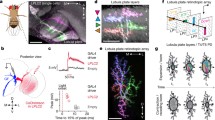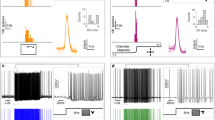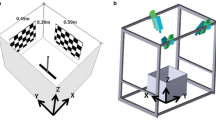Abstract
We challenged tethered, flying locusts with visual stimuli looming from the side towards one eye in a way that mimics the approach of a predatory bird. Locusts respond to the lateral approach of a looming object with steering movements and a stereotyped, rapid behaviour in which the wingbeat pattern ceases and the wings are swept into a gliding posture. This gliding behaviour may cause the locust to dive. The gliding posture is maintained for 200 ms or more after which flight is resumed with an increased wingbeat frequency or else the wings are folded. A glide begins with a strong burst of activity in the mesothoracic second tergosternal motor neuron (no. 84) on both sides of the locust. Recordings of descending contralateral movement detector (DCMD) activity in a flying locust show that it responds to small (80-mm diameter) looming stimuli during tethered flight, with a prolonged burst of spikes that tracks stimulus approach and reaches peak instantaneous frequencies as, or after, stimulus motion ceases. There is a close match between the visual stimuli that elicit a gliding behaviour and those that are effective at exciting the DCMD neuron. Wing elevation into the gliding posture occurs during a maintained burst of high frequency DCMD spikes.







Similar content being viewed by others
Abbreviations
- DCMD:
-
Descending contralateral movement detector
- EMG:
-
Electromyogram
- IR:
-
Infra-red
- LGMD:
-
Lobula giant movement detector
- MN:
-
Motor neuron
References
Baker PS, Cooter RJ (1979a) The natural flight of the migratory locust, Locusta migratoria L. I. Wing movements. J Comp Physiol A 131:79–87
Baker PS, Cooter RJ (1979b) The natural flight of the migratory locust, Locusta migratoria L. II. Gliding. J Comp Physiol A 131:89–94
Baker PS, Gewecke M, Cooter RJ (1981) The natural flight of the migratory locust, Locusta migratoria L. III. Wing-beat frequency, flight speed and attitude. J Comp Physiol A 141:233–237
Boyan GS (1989) Synaptic input converging onto an identified premotor interneuron in the locust is gated according to modality. Naturwissenschaften 76:431–433
Burrows M, Rowell CHF (1973) Connections between descending visual interneurons and metathoracic motoneurons in the locust. J Comp Physiol A 85:221–234
Camhi JM, Tom W, Volman S (1978) The escape behaviour of the cockroach Periplaneta americana II. Detection of natural predators by air displacement. J Comp Physiol A 128:203–212
Casas J (2004) Air flow sensing: from physical ecology in the field to nanotech implementation. Presented at the 7th congress of the International Society for Neuroethology, Denmark. Neuromorphic Approaches to Neuroethology Abstract SY38
Cloupeau M, Devillers JF, Devezeaux D (1979) Direct measurements of instantaneous lift in desert locust; comparison with Jensen’s experiments on detached wings. J Exp Biol 80:1–15
Cramp S (1977) Handbook of the Birds of Europe, the Middle East and North Africa. The birds of the Western Paleartic. Oxford University Press, New York
Dawson JW, Kutsch W, Robertson RM (2004) Auditory-evoked evasive manoeuvres in free-flying locusts and moths. J Comp Physiol A 190:69–84
Fry CH, Fry K (1992) Kingfishers, bee-eaters and rollers. Christopher Helm A&C Black, London
Gabbiani F, Krapp HG, Laurent G (1999) Computation of object approach by a wide-field motion-sensitive neuron. J Neurosci 19:1122–1141
Gibson JJ (1958) Visually controlled locomotion and visual orientation in animals. Br J Psychol 49:182–194
Gray JR, Lee JK, Robertson RM (2001) Activity of descending contralateral movement detector neurons and collision avoidance behaviour in response to head-on visual stimuli in locusts. J Comp Physiol A 187:115–129
Herberholz J, Sen MM, Edwards DH (2004) Behavioural and neural responses in crayfish to attacks from a natural predator. Presented at the 7th Congress of the International Society for Neuroethology, Denmark. Muscle, Motor and Sensory-Motor Systems Abstract PO233
Hoy RR, Nolen T, Brodfuehrer P (1989) The neuroethology of acoustic startle and escape in flying insects. J Exp Biol 146:287–306
Hudleston JA (1958) Some notes on the effects of bird predators on hopper bands of the desert locust (Schistocerca gregaria Forskal). Entomol Monthly Mag 94:210–214
Jensen M (1956) Biology and physics of locust flight III. The aerodynamics of locust flight. Philos Trans R Soc Lond B 239:511–552
Judge SJ, Rind FC (1997) The locust DCMD, a movement-detecting neurone tightly tuned to collision trajectories. J Exp Biol 200:2209–2216
Libersat F, Hoy RR (1991) Ultrasonic startle behaviour in bushcrickets (Orthoptera; Tettigoniidae). J Comp Physiol A 169:507–514
Miller LA (1975) The behaviour of flying green lacewings, Chrysopa carnea, in the presence of ultrasound. J Insect Physiol 21:205–219
Nickerson B (1958) Some observations of the carmine bee-eater Merops nubicus Gmelin in the French Sudan. Ibis 100:454–457
O’Shea M, Rowell CHF (1975) A spike-transmitting electrical synapse between visual interneurons in the locust movement detector system. J Comp Physiol A 97:143–158
O’Shea M, Rowell CHF, Williams JLD (1974) The anatomy of a locust visual interneurone: the descending contralateral movement detector. J Exp Biol 60:1–12
Pearson KG, Boyan GS, Bastiani M, Goodman CS (1985) Heterogenous properties of segmentally homologous interneurons in the ventral nerve cord of locusts. J Comp Neurol 233:133–145
Pfau HK (1977) Zur Morphologie und Funktion des Vorderfügels und Vorderfügelgelenks von Locusta migratoria L. Fortschr Zool 24:341–345
Pond CM (1972) Neuromuscular activity and wing movements at the start of flight of Periplaneta americana and Schistocerca gregaria. J Comp Physiol 78:192–209
Reichert H, Rowell CHF (1985) Integration of nonphaselocked exteroceptive information in the control of rhythmic flight in the locust. J Neurophysiol 53:1201–1218
Reichert H, Rowell CHF (1986) Neuronal circuits controlling flight in the locust: how sensory information is processed for motor control. Trends Neurosci 9:281–283
Rind FC (1984) A chemical synapse between two motion detecting neurons in the locust brain. J Exp Biol 110:143–167
Rind FC, Santer RD (2004) Collision avoidance and a looming sensitive neuron: size matters but biggest is not necessarily best. Proc R Soc Lond B 271:S27-S29
Rind FC, Simmons PJ (1992) Orthopteran DCMD neuron: a reevaluation of responses to moving objects. I. Selective responses to approaching objects. J Neurophysiol 68:1654–1666
Robert D (1989) The auditory behaviour of flying locusts. J Exp Biol 147:279–301
Robertson RM, Johnson AG (1993) Collision avoidance of flying locusts: steering torques and behaviour. J Exp Biol 183:35–60
Robertson RM, Reye DN (1992) Wing movements associated with collision-avoidance manoeuvres during flight in the locust Locusta migratoria. J Exp Biol 163:231–258
Roeder KD (1962) The behaviour of free flying moths in the presence of artificial ultrasonic pulses. Anim Behav 10:300–304
Roeder KD (1967) Nerve cells and insect behaviour. Harvard University Press, Cambridge
Schlotterer GR (1977) Response of the locust descending movement detector neuron to rapidly approaching and withdrawing visual stimuli. Can J Zool 55:1372–1376
Schulze W, Schul J (2001) Ultrasound avoidance behaviour in the bushcricket Tettigonia viridissima (Orthoptera: Tettigoniidae). J Exp Biol 204:733–740
Simmons PJ (1980a) A locust wind and ocellar brain neurone. J Exp Biol 85:281–294
Simmons PJ (1980b) Connexions between a movement-detecting visual interneurone and flight motoneurones of a locust. J Exp Biol 86:87–97
Simmons PJ, Rind FC (1992) Orthopteran DCMD neuron: a reevaluation of responses to moving objects. II. Critical cues for detecting approaching objects. J Neurophysiol 68:1667–1682
Simmons PJ, Rind FC (1997) Responses to object approach by a wide field visual neurone, the LGMD2 of the locust: characterization and image cues. J Comp Physiol A 180:203–214
Smith KD, Popov GB (1953) On birds attacking desert locust swarms in Eritrea. The Entomologist 86:3–7
Snodgrass RE (1929) The thoracic mechanism of a grasshopper and its antecedents. Smithson. Misc Collns 82:1–111
Symmons PM, Cressman K (2001) Desert locust guidelines 1. Biology and behaviour. Food and Agriculture Organisation of the United Nations, Rome
Thomas ALR, Taylor GK (2001) Animal flight dynamics I. Stability in gliding flight. J Theor Biol 212:399–424
Weis-Fogh T (1956) Biology and physics of locust flight II. Flight performance of the desert locust (Schistocerca Gregaria). Philos Trans R Soc Lond B 239:459–510
Wheatstone C (1852) Contributions to the physiology of vision. II. Philos Trans R Soc Lond B 142:1–18
Yager DD, May ML (1990) Ultrasound-triggered, flight-gated evasive maneuvers in the praying mantis Parasphendale agrionina II. Tethered flight. J Exp Biol 152:41–58
Yager DD, May ML, Fenton MB (1990) Ultrasound-triggered, flight-gated evasive maneuvers in the praying mantis Parasphendale agrionina I. Free flight. J Exp Biol 152:17–39
Acknowledgements
Supported by the Gatsby Charitable Foundation and the BBSRC (Grant 13/S17899). We thank Dr. Jeremy Thomason for the use of the high-speed camera equipment in preliminary experiments, Bob McGowan (National Museums of Scotland) and John Curton (Columbus Zoo and Aquarium) for providing the carmine bee-eater measurements, and Dr. Hanno Fischer for helpful discussions. The experiments described in this manuscript comply with the ‘Principles of animal care’, publication No. 86-23 revised 1985, of the National Institute of Health and also with the current laws of the UK.
Author information
Authors and Affiliations
Corresponding author
Rights and permissions
About this article
Cite this article
Santer, R.D., Simmons, P.J. & Rind, F.C. Gliding behaviour elicited by lateral looming stimuli in flying locusts. J Comp Physiol A 191, 61–73 (2005). https://doi.org/10.1007/s00359-004-0572-x
Received:
Revised:
Accepted:
Published:
Issue Date:
DOI: https://doi.org/10.1007/s00359-004-0572-x




